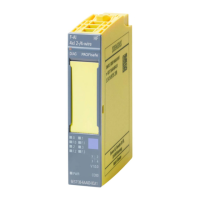General Technical Specifications
6.3 Electromagnetic Compatibility
ET 200S Distributed I/O System - Fail-Safe Modules
Installation and Operating Manual, 08/2008, A5E00103686-07
53
6.3 Electromagnetic Compatibility
Introduction
This chapter presents information about immunity to interference of fail-safe modules and
about EMC conformity.
Definition of EMC
Electromagnetic compatibility is the ability of an electrical device to function in its
electromagnetic environment in a satisfactory manner without affecting this environment.
Fail-safe modules also comply with the requirements of the EMC law for the European
Single Market. As a requirement, the ET 200S distributed I/O system must comply with the
specifications and guidelines for electrical configuration.
Pulse-Shaped Interference
The following table presents the electromagnetic compatibility of fail-safe modules with
regard to pulse-shaped interference.
Pulse-Shaped Interference Tested With Degree of Severity
Electrostatic discharge in
accordance with IEC 61000-4-2
(DIN VDE 0843 Part 2)
8 kV
6 kV (cabinet installation mandatory)
4 kV (no cabinet installation)
3 (air discharge)
3 (contact discharge)
Burst pulse (rapid transient
interference) in accordance with
IEC 61000-4-4
(DIN VDE 0843 Part 4)
2 kV (supply line)
2 kV (signal line)
3
4
Zone B in accordance with IEC 61131-2
Surge in accordance with IEC 61000-4-5 (DIN VDE 0839 Part 10)
Degrees of severity 2 and 3 require an external protective circuit (see
paragraph below)
More stringent requirements to EN 298 regarding electromagnetic
interference for modules which conform to this standard.
Asymmetrical connection
Symmetrical connection
1 kV (supply line)
1 kV (signal lead/data lead)
2 kV (supply line)
0.5 kV (supply line)
0.5 kV (signal lead/data lead)
1 kV (supply line)
1 kV (signal lead/data lead)
2
3
2
3
